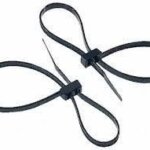In the critical field of fire safety, every second counts. Proper organization of firefighting equipment can mean the difference between life and death. Cable ties, often overlooked, play a crucial role in keeping essential gear organized and readily accessible. This article explores how cable ties contribute to fire safety by helping organize firefighting equipment effectively.
The Importance of Organized Firefighting Equipment
Firefighters face high-pressure situations where quick access to equipment is paramount. Disorganized gear can lead to delays, potentially costing lives. Well-organized equipment allows firefighters to respond swiftly and efficiently to emergencies. Cable ties offer a simple yet effective solution for keeping firefighting tools and gear in order.
Types of Cable Ties for Firefighting Equipment
Fire-resistant cable ties are essential for organizing firefighting gear. These specialized ties withstand high temperatures, ensuring they remain intact during fire emergencies. UV-resistant ties prove valuable for equipment stored in sunlight-exposed areas. Heavy-duty cable ties offer the strength needed to secure larger pieces of equipment securely.
Reusable cable ties provide flexibility for equipment that requires frequent inspection or replacement. Color-coded ties help in quick identification of different types of gear. This color-coding system can significantly reduce response times in emergency situations.
Organizing Hoses with Cable Ties

Fire hoses require proper storage to maintain their integrity and ensure quick deployment. Zip ties help keep hoses neatly coiled and secured. This organization prevents tangling and damage, allowing for rapid unrolling when needed. Firefighters use large, durable zip ties to fasten hose bundles securely.
Color-coded ties can indicate hose lengths or types, facilitating quick selection during emergencies. Some fire departments use zip ties to create temporary repairs on damaged hoses in the field. This quick fix can help maintain water flow until proper repairs can be made.
Securing Personal Protective Equipment (PPE)
Firefighters' personal protective equipment must be readily available and in good condition. Zip ties help organize PPE sets, keeping helmets, gloves, and boots together. This organization ensures firefighters can quickly don their gear when responding to a call.
Zip ties secure gear bags, preventing items from falling out during transport. Some departments use cable ties to attach identification tags to PPE. This practice helps track equipment and ensures each firefighter has their properly fitted gear.
Managing Tools and Small Equipment
Fire trucks carry a vast array of tools and small equipment. Cable ties help organize these items efficiently within compartments. Bundling similar tools together with cable ties makes retrieval faster and easier. This organization is crucial when every second counts in an emergency response.
Cable ties can create custom holders for oddly shaped tools within truck compartments. Some firefighters use cable ties to secure backup tools to their gear. This ensures they have essential equipment readily available even if separated from the truck.
Organizing Communication Equipment
Clear communication is vital in firefighting operations. Cable ties help manage communication equipment cables, preventing tangling and damage. Organized cables ensure radios and other devices remain functional and easily accessible. Color-coded ties can differentiate between various types of communication equipment.
Some departments use cable ties to create temporary antenna mounts in the field. This improvisation can improve communication in areas with poor signal reception. Cable ties also secure charging stations for communication devices within fire stations.
Maintaining Fire Extinguishers
While fire extinguishers don't typically require extensive organization, cable ties still play a role. Ties can secure inspection tags to extinguishers, ensuring important information is always attached. Some departments use cable ties to group similar types of extinguishers for storage.
In training scenarios, zip ties can mark extinguishers for specific exercises. This organization helps in conducting efficient and effective training sessions. Zip ties also secure extinguisher mounting brackets in vehicles, preventing movement during transit.
Organizing Rescue Equipment
Rescue operations often involve specialized equipment that must be carefully organized. Zip ties help bundle ropes and secure them for quick deployment. Organized ropes are crucial for swift and safe rescue operations. Ties also secure various components of rescue kits, keeping them together and easily transportable.
Some rescue teams use zip ties to create improvised harnesses or secure victims during extractions. While not a replacement for proper equipment, these temporary solutions can be lifesaving in emergencies. Zip ties also help organize and secure inflatable rescue devices when not in use.
Best Practices for Using Zip Ties in Fire Safety
When using zip ties for firefighting equipment, certain best practices should be followed. Always choose fire-resistant ties for equipment that may be exposed to high temperatures. Regularly inspect and replace zip ties to ensure they remain strong and functional. Avoid over-tightening ties, as this can damage equipment or make it difficult to release quickly.
Implement a standardized color-coding system across the department for consistency. Train all personnel on the proper use and disposal of zip ties. Consider environmental factors when selecting ties for equipment stored outdoors.
Environmental Considerations
While zip ties are invaluable in organizing firefighting equipment, their environmental impact should be considered. Opt for reusable ties when possible to reduce waste. Properly dispose of used zip ties to prevent environmental pollution. Some departments are exploring biodegradable options for non-critical applications.
Conclusion
Cable ties play a vital yet often unrecognized role in fire safety by helping organize crucial firefighting equipment. From securing hoses to managing personal protective gear, these simple tools contribute significantly to the efficiency and effectiveness of firefighting operations. By implementing proper cable tie usage and following best practices, fire departments can enhance their readiness and response times, ultimately saving more lives and property.
As fire safety technology continues to evolve, the humble cable tie remains an essential tool in keeping firefighting equipment organized and accessible. Its versatility, strength, and simplicity make it an indispensable asset in the critical field of fire safety and emergency response.

